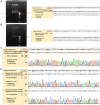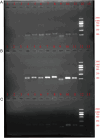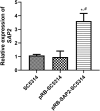Construction of Candida albicans pRB895-SAP2-SC5314 With SAP2 High Expression and Its Effects on Adhesion
- PMID: 39727206
- PMCID: PMC11776491
- DOI: 10.1002/jcla.25144
Construction of Candida albicans pRB895-SAP2-SC5314 With SAP2 High Expression and Its Effects on Adhesion
Abstract
Background: SAP2 is closely associated with the pathogenicity and drug resistance of Candida albicans (C. albicans). Our study aimed to construct C. albicans with SAP2 overexpression (pRB895-SAP2-SC5314) to explore the influence of SAP2 on the adhesion of C. albicans and predict the interaction between magnolol and Sap2 by molecular docking.
Methods: The recombinant plasmid pRB895-SAP2 with high SAP2 expression was prepared using a plasmid extraction kit and transformed into C. albicans strain SC5314 using an improved lithium acetate conversion method to construct PRB895-SAP2-SC5314. Quantitative reverse transcription polymerase chain reaction (qRT-PCR) was performed to detect the expression of adhesion-related genes in the different strains. Molecular docking and visual analysis of magnolol and Sap2 were performed using the CB-DOCK2 platform.
Results: Compared with the control SC5341 and SC5341 transfected with pRB895, SAP2 expression was significantly higher in the pRB895-SAP2-SC5314 strain (p < 0.05). Based on the sequencing and mapping results, the pRB895-SAP2-SC5314 strain was successfully prepared. SAP2 overexpression significantly downregulated ALS1 expression (p < 0.05), whereas ALS3, TEC1, HOG1, PHR1, and TUP1 expression was downregulated in C. albicans (p < 0.05). The optimal docking result for magnolol and Sap2 protein was -8.1 kcal/mol of vina score, which was considered good docking.
Conclusions: SAP2 overexpression may strengthen the adhesion and pathogenicity of C. albicans, and magnolol may act as an Sap2 inhibitor that affects the adhesion of C. albicans.
Keywords: C. albicans; SAP2; SAP2adhesion; magnolol; pRB895‐SAP2‐SC5314 strain.
© 2024 The Author(s). Journal of Clinical Laboratory Analysis published by Wiley Periodicals LLC.
Conflict of interest statement
The authors declare no conflicts of interest.
Figures





Similar articles
-
Impact of high SAP2 expression on the invasion and adhesion abilities of Candida albicans in vaginal epithelial cells.Biochem Biophys Res Commun. 2025 Sep 1;777:152147. doi: 10.1016/j.bbrc.2025.152147. Epub 2025 Jun 14. Biochem Biophys Res Commun. 2025. PMID: 40570640
-
Magnolol as a potent antifungal agent inhibits Candida albicans virulence factors via the PKC and Cek1 MAPK signaling pathways.Front Cell Infect Microbiol. 2022 Jul 22;12:935322. doi: 10.3389/fcimb.2022.935322. eCollection 2022. Front Cell Infect Microbiol. 2022. PMID: 35937692 Free PMC article.
-
Effects of magnolol and honokiol on adhesion, yeast-hyphal transition, and formation of biofilm by Candida albicans.PLoS One. 2015 Feb 24;10(2):e0117695. doi: 10.1371/journal.pone.0117695. eCollection 2015. PLoS One. 2015. PMID: 25710475 Free PMC article.
-
[What functions do six different genes for secretory proteinases have in Candida albicans?].Mycoses. 1998;41 Suppl 1:47-50. doi: 10.1111/j.1439-0507.1998.tb00583.x. Mycoses. 1998. PMID: 9717386 Review. German.
-
The ALS gene family of Candida albicans.Trends Microbiol. 2001 Apr;9(4):176-80. doi: 10.1016/s0966-842x(01)01984-9. Trends Microbiol. 2001. PMID: 11286882 Review.
References
MeSH terms
Substances
Grants and funding
LinkOut - more resources
Full Text Sources
Miscellaneous

